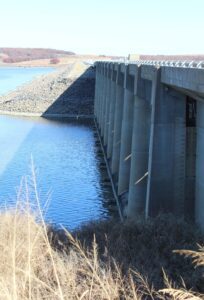

Based on USACE studies dating as far back as 2007, the City has pursued reallocating 10 million gallons of water per day (mgd) of flood control to water supply at Hulah Lake, the City’s primary water supply source, and 10.5 mgd of flood control to water supply at Copan Lake.
Those requests have been denied pending further legislation, City Manager Mike Bailey said during a State of the City presentation earlier this week.
“It’s not available on Copan or Hulah Lake based on the condition of the dams,” Bailey said. “So once again we have hit a brick wall. But we will continue moving ahead with our elected representatives, and we will continue to pursue this. We believe there is a solution, and (we will find) a way through this.”
According to Water Utilities Director Terry Lauritsen, DSAC (Dam Safety Action Classification) ratings were created from a 1977 Federal Dam Safety Program. Ratings range from 1 to 5, with 1 being Very High Urgency (with normal operation, the dam is certain to fail within a few years) to 5, which is Normal. Three is moderate urgency.
“Apparently a DSAC rating had not been assigned to the dams at Hulah and Copan Lake until 2008 when USACE assigned both dams a rating of 3,” said Lauritsen. “Interestingly, this was after the December 2007 completion of the Water Supply and Conveyance Final Report, which was performed by the USACE and recommended water reallocation at both Hulah and Copan Lake.”
Lauritsen said that per USACE policies, reallocation studies are not allowed at dams with a DSAC rating of 1, 2, or 3.
“There are exceptions in their policy to allow a water reallocation study, but implementing reallocation is not allowed on a dam with a rating of 1, 2 or 3,” he said. “The DSAC for Copan was updated in 2021 and the rating remained at a 3. The updated DSAC for Hulah is currently being evaluated and is anticipated to be complete in late summer or fall of this year.”
Lauritsen said when the USACE was conducting Bartlesville water supply and conveyance study, it appears no one from the Dam Safety division was consulted regarding the reallocation recommendation.
“It was likely that the DSAC analysis for Hulah and Copan were well underway while the USACE was conducting the water supply study,” he said. “There is no mention of a DSAC rating or potential impacts within the water supply final report.”
The dams at both lakes are owned by and are the responsibility of USACE, he said.
Lauritsen said to move forward with additional water rights for Hulah Lake, legislation will be needed to fund several studies, including:
- Determine what improvements are needed at Hulah Lake’s dam to facilitate a DSAC rating of 4 accounting for a 10 percent reallocation of flood control to water supply (raising the lake 6.74 feet)
- Study for up to 10 percent reallocation of flood control to water supply at Hulah Lake
The Water Resources Committee had identified reallocation as the most cost-effective measure that could help Bartlesville and the surrounding area meet long-term water supply needs. The WRC has met regularly since severe drought conditions threatened local water supply last year.
Lauritsen said staff will report the recent findings to the committee at their next meeting, likely to occur in mid to late summer, once the preliminary results for the Kaw Lake pipeline and pump station study are available.
The WRC also recommended the City continue to explore potential partnerships with other communities and tribes to reduce the cost of acquiring water rights at Kaw Lake, located in Kay County. The lake has 40 mgd available; however, to acquire water rights and construct the infrastructure to access it would be an estimated cost “in the hundreds of millions of dollars.”
The City is currently awaiting a consultant report on the cost and feasibility of pursuing water rights at Kaw Lake.
